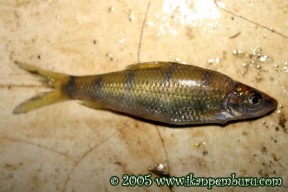Acrossocheilus iridescens
SynonymsTop ↑
Cyclocheilichthys iridescens Nichols & Pope, 1927; Barbus barbodon Nichols & Pope, 1927; Barbus paradoxus quinquefasciatus Koller, 1926
Etymology
Acrossocheilus: from the Greek a- (Gr. ἀ-), meaning ‘without’, krossós (Gr. κροσσός), meaning ‘fringe, tassel’, and cheílos (Gr. χείλος), meaning ‘lip’, in reference to the smooth upper lip in members of this genus.
iridescens: Neo-Latin term meaning ‘iridescent or rainbow-like’, presumably in reference to this species’ attractive colour pattern.
Classification
Order: Cypriniformes Family: Cyprinidae
Distribution
This species is known from the Nam Xam and Nam Ma basins in Laos, the Red River basin in Vietnam and Yunnan province, southwestern China, plus Hainan Island, although some populations are of questionable taxonomic status. For example, records of the congener A. paradoxus from Hainan refer to A. iridescens, while those from the Pearl River (Zhu Jiang) in China pertain to A. longipinnis.
Type locality is ‘Nodoa, Hainan Island, China’, and the species sensu stricto may actually be restricted to Hainan.
Maximum Standard Length
200 – 300 mm.
NotesTop ↑
A. iridescens and its closest relative A. longipinnis can be distinguished from all other barred species of Acrossocheilus by the following characters: wider (vs. narrower) black vertical bars on the flank in adults, each six to eight (vs. no more than five) scales in width; a horse-shoe shaped (vs. arched) mouth gape; rostral barbel located posteriorly (vs. anteriorly) to a horizontal line through the anteriormost margin of the lower jaw; two postlabial grooves extending anteromedially beyond (vs. away from) a horizontal line through the roots of the rostral barbels.
A. iridescens is told apart from A. longipinnis by lacking (vs. possessing) a first branched dorsal-fin ray extended into a filament , having relatively wider vertical black body bars in juveniles, and a slightly concave to straight (vs. deeply concave) distal dorsal-fin margin.
The genus Acrossocheilus is restricted to southern China, northern Vietnam and northern Laos. It can be distinguished from related genera by the following combination of characters: rostral fold present; lips fleshy and continuous around corners of mouth; lower lip with a median interruption; mouth inferior; horny sheath on lower jaw; two pairs of barbels; last simple ray of dorsal fin osseous with a serrated or smooth posterior margin.
References
- Nichols, J. T. and C. H. Pope, 1927 - Bulletin of the American Museum of Natural History v. 54 (art. 2): 321-394
The fishes of Hainan. - Kottelat, M., 2013 - The Raffles Bulletin of Zoology Supplement 27: 1-663
The fishes of the inland waters of southeast Asia: a catalogue and core bibiography of the fishes known to occur in freshwaters, mangroves and estuaries. - Kottelat, M., 2000 - Journal of South Asian Natural History 5(1): 37-82
Diagnoses of a new genus and 64 new species of fishes from Laos (Teleostei: Cyprinidae, Balitoridae, Bagridae, Syngnathidae, Chauhuriidae and Tetraodontidae). - Kottelat, M., 2001 - WHT Publications, Colombo: 1-198
Fishes of Laos. - Lan, Z.-J., B.-P. Chan and J. Zhao, 2014 - Zoological Systematics 39(3): 433-441
Acrossocheilus multistriatus, a new species of barbine fish (Teleostei: Cyprinidae) from the Zhujiang River basin, south China. - Yuan, L.-Y., B. P. L. Chan and E Zhang, 2012 - Zootaxa 3586: 160-172
Acrossocheilus longipinnis (Wu 1939), a senior synonym of Acrossocheilus stenotaeniatus Chu & Cui 1989 from the Pearl River basin (Teleostei: Cyprinidae).


